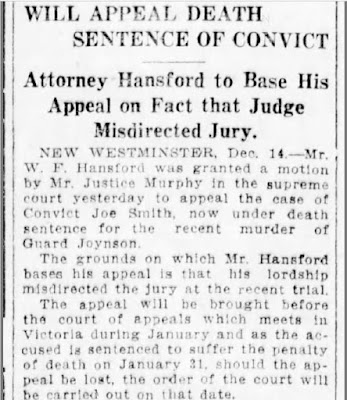Hello Friends,
Here is the story of two convicts who gained fame for an ambitious escape attempt that went oh so wrong. These lads are now interred at the B.C. Penitentiary's Cemetery, a small plot of land which lays west across a ravine from where the prison once stood in New Westminster.
Herman and Joseph, both young men in their early 20's, met while serving 10 years each in "the Pen" (opened 1878 & closed 1980) for robbery attempts.
In 1911 Vancouver was going through an expansion boom, and the number of prisoners in "the Pen" grew to 331 the following year. Browsing through historical Vancouver newspapers, I noticed a large number of articles describing robberies in the city and surrounding areas. Some of violent nature, some simply theft of handbags or socks and even a loaf of bread. One of North America's biggest bank vault robberies took place in September of 1911, the thieves (was it 3 or 5 men? Reports show confusion with the number) getting away with more than a quarter million dollars.
Construction was booming in the city with the openings of new business buildings, theatres, streetcar expansions, and a company of small ferry boats began operating on the Fraser River. The population of Vancouver had increased to over 120,000 by 1913, of which a study indicated 34% were British.
What was to come was the first and only hanging at the B.C. Penitentiary, and this was met with controversy and confusion of who actually shot the fatal bullet which killed Prison Guard Joynson.
Meet prisoners #1628 - Herman Wilson and #Unknown - Joseph Smith.
While Herman was born in the Toronto area and his occupation was listed as "waiter", Joseph's death certificate indicates he was a "sailor" from England.
On March 1st, 1911 Joseph Smith walked into a jewellery store in Vancouver's busy section with the intent to steal.
The first account appeared in two newspapers, the Daily Colonist and the Vancouver Daily World.
 |
| Courtesy BritishColonist.ca - Daily Colonist (Mar.02, 1911) article in 2 parts |
This was the first time reported, of any thief using "ammonia" in a squirt gun to stun the shop owner in an attempt to make off with the loot. Gold jewellery. Unfortunately for Joseph, the shop keep clung to him and would not let go. Police arrived swiftly.
 |
| Courtesy Newspapers.com - Vancouver Daily World (Mar.02, 1911) |
In short, Joseph Smith walked into the shop around 5:20 pm and asked to be shown some jewellery. As the shop keep leaned over to show one of the pieces, he lifted his squirt gun and shot him in the eyes with the ammonia liquid. Instantly the shop keep grabbed for Joseph's neck and shouted for help. The two men wrestled and ended up on the shop floor in a struggle. The butcher, from next door, came running in and helped restrain Joseph until the police arrived. Once in the police station, Joseph provided little information, but it is noted that he stated he was a Canadian and a sailor.
 |
| Courtesy Newspapers.com - Vancouver Daily World (Mar.08, 1911) |
 |
| Warden Brown,1907 - NW Archives |
How Herman Wilson ended in the prison is a bit of a mystery; although it is noted in the articles and documents found that he had committed a violent highway robbery near Fernie, B.C. which landed him with a 10 year sentence. His death certificate indicates he had been labelled as a "convict" since May 23, 1912. Searching historical newspapers for the period provided several robbery accounts but none in his full name. As such, the account of when the Fernie Assizes was next scheduled is shown below; yet it confirms the struggle of identifying which "Wilson" is being referred to:
 |
| Courtesy BritishColonist.ca - The Daily Colonist (Apr.18, 1912) |
 |
| Courtesy BritishColonist.ca - The Daily Colonist (May 26, 1912) |
 |
| Above - Convict Deaths in B.C. Penitentiary (website listed in document) |
 |
| Courtesy BC Archives Genealogy - Death Certificate of Herman Wilson |
 |
| Courtesy of Newspapers.com - Vancouver Daily World (Oct.07, 1912) |
In "Four Walls in the West" by Jack David Scott, a description of the incident is noted (pages 52-53), although it incorrectly names Wilson as "Norman" instead of "Herman". The account of the attempt tells us that both inmates were working with others crushing rock in a yard near the east wall of the prison grounds as punishment; Smith for his previous escape attempt, and Wilson for trying to smuggle an iron bar out of the workshop. The guard on duty of the detail was Craig. He witnessed Smith walk up to Wilson and say something, then walk back to his place in the line. Talking with one another is not permitted, therefore Craig stepped up to Smith and reprimanded him. Upon turning away, Smith hit the guard with his mallet. Craig recovered and began fighting with Smith until Wilson joined in. The two inmates grabbed Craig's gun and ran off towards a shop building entrance, while another convict went to Craig's aid. Tower guards witnessed the entire thing but did not shoot; instead, they sounded the alarm bell. Guard Round was locking up the shop door as Wilson and Smith ran up and pointed the revolver at him. No one knew the revolver was empty of bullets. The two took Round's revolver and forced him to unlock the door to a tunnel which led under the wall dividing the shops from the brickyard. They then escorted the guard through the tunnel and into another yard. Walking behind Round, they approached Guard Morrison, who was forced to surrender his gun and join the trio in walking towards a post guarded by Elson. He was instructed to throw down his rifle and keys. Elson did so but kept his revolver. When Wilson bent down to pick up the keys, he was shot in the neck by Elson. Then Joynson ran onto the scene and opened up fire. Smith fired in rapid succession at Joynson, while Round threw himself at Smith, thus pinning him down until the Deputy Warden and an Instructor reached them. Both were armed with Winchester rifles. Smith surrendered. Joynson was lying in great pain and Wilson had been shot by Elson. Guard Joynson died within the hour, while Wilson was taken to the Royal Columbian Hospital.
An inquest to Joynson's death began, and the volley of newspaper reports continued.
 |
| Courtesy of BritishColonist.ca - Daily Colonist (Oct.08, 1912) |
 |
| Courtesy Newspapers.com - Vancouver Daily World (Oct.08, 1912) |
 |
| Courtesy Newspapers.com - Vancouver Daily World (Oct.09, 1912) |
 |
| Courtesy Newspapers.com - Vancouver Daily World (Oct.11, 1912) |
On October 13th the Daily Colonist indicates in their report that Wilson and Smith had actually wounded another officer.
 |
| Courtesy BritishColonist.ca - The Daily Colonist (Oct.13, 1912) |
 |
| Courtesy of Newspapers.com - Vancouver Daily World (Oct.30, 1912) |
 |
| Courtesy BritishColonist.ca - Daily Colonist (Oct.31, 1912) |
 |
| Courtesy Newspapers.com - Morning Register, Eugene Oregon (Oct.31, 1912) |
 |
| Courtesy Newspapers.com - Seattle Star, Seattle Washington (Oct31. 1912) |
 |
| Courtesy Peel Library, University of Alberta - Edmonton Bulletin (Oct.31, 1912) |
 |
| Courtesy UBC: BC Historical Newspapers - Delta Times (Nov.02, 1912) |
It took some searching, but I finally found a newspaper report about Wilson's murder trial.
 |
| Courtesy UBC: BC Historical Newspapers - Delta Times (Nov.23, 1912) |
 |
| Courtesy Newspapers.com - Vancouver Daily World (Dec.14, 1912) |
 |
| Courtesy BritishColonist.ca - Daily Colonist (Dec.17, 1912) |
 |
| Courtesy National Archives of Canada - 1994 |
 |
| Courtesy BritishColonist.ca - Daily Colonist (Jan.19, 1913) |
 |
| Courtesy Newspapers.com - Vancouver Daily World (Jan.23, 1913) |
 |
| Courtesy Newspapers.com - Vancouver Daily World (Jan.28, 1913) |
 |
| Courtesy Newspapers.com - Vancouver Daily World (Jan.31, 1913) |
 |
| Courtesy Peel Library, University of Alberta - Edmonton Bulletin (Feb.01, 1913) |
 |
| Courtesy Newspapers.com - Vancouver Daily World (Feb.01, 1913) |
The article from Edmonton indicates Smith's mother had written a "farewell letter" but they did not give it to the convict for fear it would "unnerve" him. Was this the right decision to make? Would you do the same if you were the Warden?
And now we come to the end of our story. Below you'll find Joseph Smith's death certificate confirming the date, time and nature of his demise. A young man on an adventure, making big mistakes that define his life and ends up hanging for a murder that had become controversial and is still talked about today.
 |
| Courtesy BC Archives Genealogy - Death Certificate of Joseph Smith |
If you have not read any of our previous accounts, please check them out. Each convicts' story is filled with interesting facts, incredible adventures and emotional effect.
01) Meet Convict 1548 - Thompson
02) Meet Convict 2370 - Walsh
03) Meet Convict 2304 - Chinley
05) Meet Convicts 1628 - Herman Wilson + Unknown# - Joseph Smith
06) Meet Convict 1659 - Y. Yoshie
07) Meet Convict 1884 - Moses Paul
08) Meet Convict 2516 - Daniel Henrick Urick
09) Meet Convict 1948 - Unknown Gim
10) Meet Convict 2938 - Reginald John Colpitts
11) Meet Convict 5603 - Stephen Poole
12) Meet Convict 3130 - Harry Davis
13) Meet Convict 2312 - Albert Hill
14) Meet Convict Unknown# - Phillip Hopkins
15) Meet Convict #9720 - Norman Donald Bottineau
16) Meet Convict #2225 - Louie Num
17) Meet Convict #3237 - Harold Gordon McMaster
18) Meet Convict #4234 - Herbert Ross
19) Meet Convict #9693 - W. Black
20) Meet Convict #6651 - Gordon Wallace
21) Meet Convict #9511 - Henry Gordon Wichmann
22) Meet Convict #3348 - Frank Wilson
20) Meet Convict #6651 - Gordon Wallace
21) Meet Convict #9511 - Henry Gordon Wichmann
22) Meet Convict #3348 - Frank Wilson
Talk soon..
Kati
Sources: "The Chuck Davis History of Metropolitan Vancouver" - Chuck Davis; "Four Walls in the West" - Jack David Scott; Vancouver Public Library - vpl.ca; Newspapers.com; The British Colonist; "Vancouver, the Romance of Canadian Cities Series" - Eric Nicol; "Vancouver, Milltown to Metropolis" - Alan Morley; B.C. Archives-Geneology; B.C. City Directories; FamilySearch.org; Ancestry.ca; Canada Archives; "Death Sentence: the New Westminster Penitentiary" - Robert C. Belyk, BC History Vol.39 No.1; New Westminster Archives; Peel library, University of Alberta; UBC-BC Historical Newspapers Open Collections; Slumach.ca - The British Columbian.






















No comments:
Post a Comment